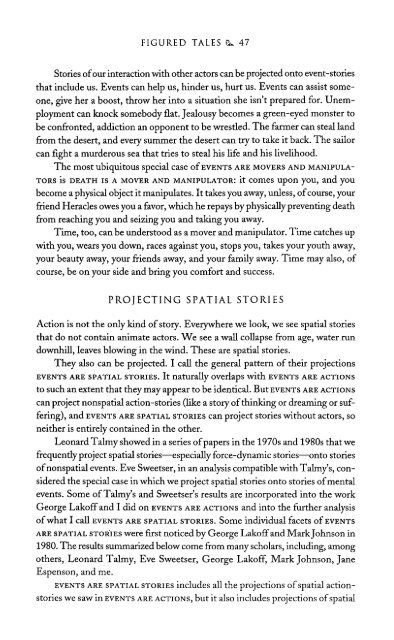The Literary Mind.pdf
The Literary Mind.pdf
The Literary Mind.pdf
You also want an ePaper? Increase the reach of your titles
YUMPU automatically turns print PDFs into web optimized ePapers that Google loves.
FIGURED TALES 47<br />
Stories of our interaction with other actors can be projected onto event-stories<br />
that include us. Events can help us, hinder us, hurt us. Events can assist someone,<br />
give her a boost, throw her into a situation she isn't prepared for. Unemployment<br />
can knock somebody flat. Jealousy becomes a green-eyed monster to<br />
be confronted, addiction an opponent to be wrestled. <strong>The</strong> farmer can steal land<br />
from the desert, and every summer the desert can try to take it back. <strong>The</strong> sailor<br />
can fight a murderous sea that tries to steal his life and his livelihood.<br />
<strong>The</strong> most ubiquitous special case of EVENTS ARE MOVERS AND MANIPULA-<br />
TORS is DEATH IS A MOVER AND MANIPULATOR: it comes upon you, and you<br />
become a physical object it manipulates. It takes you away, unless, of course, your<br />
friend Heracles owes you a favor, which he repays by physically preventing death<br />
from reaching you and seizing you and taking you away.<br />
Time, too, can be understood as a mover and manipulator. Time catches up<br />
with you, wears you down, races against you, stops you, takes your youth away,<br />
your beauty away, your friends away, and your family away. Time may also, of<br />
course, be on your side and bring you comfort and success.<br />
PROJECTING SPATIAL STORIES<br />
Action is not the only kind of story. Everywhere we look, we see spatial stories<br />
that do not contain animate actors. We see a wall collapse from age, water run<br />
downhill, leaves blowing in the wind. <strong>The</strong>se are spatial stories.<br />
<strong>The</strong>y also can be projected. I call the general pattern of their projections<br />
EVENTS ARE SPATIAL STORIES. It naturally overlaps with EVENTS ARE ACTIONS<br />
to such an extent that they may appear to be identical. But EVENTS ARE ACTIONS<br />
can project nonspatial action-stories (like a story of thinking or dreaming or suffering),<br />
and EVENTS ARE SPATIAL STORIES can project stories without actors, so<br />
neither is entirely contained in the other.<br />
Leonard Talmy showed in a series of papers in the 1970s and 1980s that we<br />
frequently project spatial stories—especially force-dynamic stories—onto stories<br />
of nonspatial events. Eve Sweetser, in an analysis compatible with Talmy's, considered<br />
the special case in which we project spatial stories onto stories of mental<br />
events. Some of Talmy's and Sweetser's results are incorporated into the work<br />
George Lakoff and I did on EVENTS ARE ACTIONS and into the further analysis<br />
of what I call EVENTS ARE SPATIAL STORIES. Some individual facets of EVENTS<br />
ARE SPATIAL STORIES were first noticed by George Lakoff and Mark Johnson in<br />
1980. <strong>The</strong> results summarized below come from many scholars, including, among<br />
others, Leonard Talmy, Eve Sweetser, George Lakoff, Mark Johnson, Jane<br />
Espenson, and me.<br />
EVENTS ARE SPATIAL STORIES includes all the projections of spatial actionstories<br />
we saw in EVENTS ARE ACTIONS, but it also includes projections of spatial















